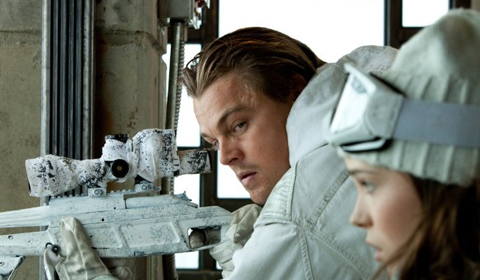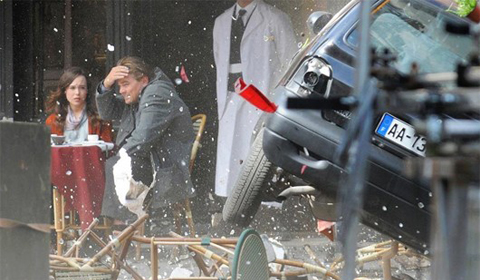
Inception. A great movie by a great many standards. It gleans elements from a wide variety of genres and skillfully combines them into something that carries enough weight to become more than the sum of its parts. Its far-reaching appeal has naturally led to an enormous outpouring of articles and discussion, not in the least geared towards theories about what it all means. A subset of such articles focuses on the relation between Inception and videogames. It should therefore come as no surprise that Christopher Nolan himself has announced an intention to craft a game based on/in the Inception universe, and this post looks at the way in which it lends itself exceptionally well as a blueprint for a (certain type of) adaptation. While a more obvious and seemingly opportunistic take on the relation between Inception and videogames, one needs only to examine the following piece of dialogue to understand why it warrants this kind of scrutiny.
ARTHUR
You're going to have to master a few tricks if you're going to build three complete dream levels.
ARIADNE
What kind of tricks?
ARTHUR
In a dream, you can cheat architecture into impossible shapes. That lets you create closed loops, like the Penrose Steps. The infinite staircase. A paradox. A closed loop like that will help you disguise the boundaries of the dream you've created.
ARIADNE
How big do these levels have to be?
ARTHUR
Well, it can be anything from the floor of a building to an entire city.
If one were to go through the Inception script and replace every instance of the word "dream" with the word "game", it couldn't get spelled out more clearly than that. "[Disguising] the boundaries of the dream" basically comes down to level designers using tricks like invisible walls and skyboxes to make the game world seem more expansive than it really is. This article even sees Inception as the perfect allegory for the process of game development. But before we can delve into the nature of Inception and how it relates to game design, we must take the reality of the industry into account and ease the minds of the money men.
In this post, I satisfied Call of Duty: Black Ops' desire to be a movie by comparing it to Transformers, a commercially successful product that neglects to challenge its audience because it feels it doesn't need to. Inception proved that a challenging story does not preclude commercial viability, given that the movie has recouped its budget fivefold. The game industry has already seen that milestone in the form of BioShock, which offered more than cheap thrills with an engaging storyline and still managed to sell. As this article points out, "great big explosions always win out". In succeeding on both those fronts, Inception has paved the way for a game set in its universe to do the same.
Another point is the track record of games based on movies. Critical reception of such games has been poor across the board, save for a few exceptions. Games like GoldenEye 007 and The Chronicles Of Riddick: Escape From Butcher Bay clearly stem from movie licenses, but haven't suffered the same fate as their ilk. The reason is that most other movie-based games are rushed through development so their release can coincide with those movies. Because of Nolan's direct involvement, a design team tackling an Inception game would have both the backing and clout to take its time and deliver a highly polished product that's more than a mere interactive promotion for another product.
With market considerations aside, we can focus on Inception's central conceit: shared dreaming. Just like the Animus allows Assassin's Creed to embrace the fact that it's a game rather than mask it, so too can shared dreaming allow an Inception game to use its very nature to its advantage. It's more than a broad, catch-all concept suitable for explaining away videogame tropes or covering for anything out of place or fantastical, it actually provides many opportunities to link story and gameplay at a fundamental level. Let's look at a few ways in which this can be implemented practically.
Imaginative and wildly divergent levels

In the game development cycle, writing often plays second fiddle to level design. A story dictating the type of level it requires is a rarity; the opposite is the norm. This is natural, because a level has to be fun before it has to mesh with the story (gameplay comes first, remember?). But sometimes this makes things hard for a writer, who has to keep adapting his work to a highly fluid situation. This GamaSutra article specifically mentions this, as well as Eisaac's comment to this post.
Inception doesn't amend this situation, but turns it into an opportunity by making a designer creating levels analogous to an architect building dreams. It's essentially the same process, as illustrated by the piece of dialogue above. So if a designer desperately wants to put an oil rig into the game, a writer's job of fitting that into an overarching narrative becomes a whole lot easier by virtue of symbolism. For instance, Ariadne builds a hospital in a snow fortress so Fischer will subconsciously put his dying father there. The actual reasoning was that Nolan was inspired by On Her Majesty's Secret Service to include a ski-chase sequence, but the setting still manages to gel with the story.
This element of symbolism has already been put to fantastic use in Tim Schafer's Psychonauts, a game which has been likened to Inception because of its similar subject matter, albeit with a more humouristic bent (for instance, emotional baggage is represented by crying suitcases when exploring people's minds). That's not to say that the analogy of architects and designers wouldn't allow for humour of its own. In fact, it creates many opportunities for metahumour. Saito might rub his face on a misaligned texture, which then becomes the architect's fault, not the designer's. This is just one example of how common design flaws become excusable when seen in the context of shared dreaming (as long as it doesn't foster complacency).
There's more specific ways in which shared dreaming provides unique opportunities for not just level design, but also gameplay. For clarity's sake, we need to pinpoint the exact technique of shared dreaming as it's established by Inception. First off, at least two people are needed (otherwise there wouldn't be much to share). The architect builds the world of the dream and the subject is brought into that dream to populate it with their subconscious. Normally the architect is also the dreamer, but this doesn't have to be the case. It's never fully explained exactly how the architect conveys the dream they've constructed to whoever is hosting it, but what's important is that it's the dreamer who can actively alter the layout of the dream while inside it.
Besides some impressive set pieces (like folding Paris on top of itself), this has interesting implications for gameplay as well. An example would be an NPC who can shape movable walls for cover or entire bridges or tunnels to get out of a tight spot. This naturally necessitates a balance between scripted and dynamic alterations. A different approach to the dream-building aspect would be to put it entirely in the player's hands (effectively turning the game into its own level editor), but that is likely too ambitious for the type of game currently being described. Something like Minecraft on the scale of a AAA title would be closer to a mechanic that allows the player to create his own levels and play them out.
The challenge of such a mechanic has already been voiced by Clint Hocking in this post. I quote: "On one hand, you want to give players unchecked freedom to design and build any environment they can imagine. Conversely, you also want player-created environments to play well within the context of your game. Designing a level editor that connects creators who want to express themselves with players who want tightly designed levels is a challenge I believe can be overcome by making level building into a game itself". This challenge is close to the issue of trying to keep a tight storyline within what amounts to a sandbox game, which is something I've expounded upon in this post. This is just the tip of the iceberg.
To fully include everything that shared dreaming permits for level design would require a post of its own. There's collapsing dreams, one dream level being affected by whatever happens in the one above it (causing a flood or loss of gravity), the limitless possibilities of Limbo, and much more. For now, let's move on.
Stealth and escalation

As Cobb specifically points out to Ariadne when she starts radically changing the dream she's in, such behaviour is not without consequences. The dream is populated by the subject filling it with their subconscious, which manifests itself as crowds of people (called "projections"). Changes to the dream tip off the subject's subconscious to the foreign nature of the dream, causing these projections to attack whoever is making the changes. This is also used as a rationalisation for the dream levels adhering so closely to reality and obeying the same rules, which makes me question Cobb's assertion that dreams only feel strange after we've woken up from them. Pointing out possible plot holes, however, is not the purpose of this post (go here for that).
When the dreamer (be that the player or an NPC) makes changes to a game level, they inevitably cause the projections to react. This would start with a crowd of people quickly glancing at the dreamer, followed by fixed, judgmental stares and hostile gestures. If more radical changes are made, the crowd starts converging and bearing down. Translating that to a specific game mechanic would introduce an element of stealth (if allowing the player himself to change things cannot be introduced somehow). To wit, the opening moments of Inception show Cobb using a silenced weapon to keep Saito's projections from detecting him.
This becomes even more of an issue when dealing with militarised projections. In the world of Inception, shared dreaming is often illegally used for corporate espionage (which is the crux of the movie's storyline). As a response, many influential individuals have received training to resist extraction, even (or especially) when asleep. This is called a "militarised subconscious" and, depending on the depth of the dream layer, either augments or wholly replaces crowds of projections with highly efficient soldiers or mercenaries who relentlessly attack whoever is invading the subject's mind. This "subsecurity", as it's called, would represent the standardised enemy that makes up the bulk of the opposition. Since militarised projections actively seek out the player, stealth is no longer a viable option, which brings us to escalation.
In the movie, there are subtle hints that the subsecurity adapts itself not only to the nature of the dream level that they're in, but also to the actions of the dreamers. Militarised projections carry weapons and employ tools that are a direct proportionate response to what the dreamers are using. Fischer's subconscious attacks Cobb's team with PMC-like mercenaries in the city level. The hotel level then has Cobb and his team forgoing any weapons, which results in besuited guards brandishing no more than sidearms. Conversely, the veritable platoon of soldiers in the snow fortress reacts to the team coming in with assault rifles by using vehicles fitted with heavy machineguns. In an Inception game, this escalation mechanic could be entirely dynamic. An example is the Wanted rating in the Grand Theft Auto series. This would require each dream level to be designed in a fashion that accommodates every manner of escalation from the start, in case the player immediately uses his grenade launcher.
The nature of the projections also logically explains and excuses common facets of crowd rendering techniques. One such facet is identical NPCs. If you pay attention, you'll notice that Cobb's team battles the same projections over and over again. This is because they're not real people. Quite the opposite, killing projections doesn't even negatively affect the subconscious generating them. Inside a dream, the (militarised) projections wouldn't need to be anything more than what they amount to in a game: faceless and mindless automatons designed to get in the player's way. As such, killing scores of these projections doesn't turn the player into a mass murderer, an outcome that plagues other games that do not dehumanise their enemies (as illustrated in this post).
Player death and save games

Fighting militarised projections obviously involves plenty of gunplay and shootouts, which will result in one of the most common occurrences in shooters: player death. This is something that has been implemented in an incredibly varied myriad of ways. The standard method is to shunt the player back to his last checkpoint or quicksave, but some games have gone the extra mile and actually used it as part of the story, which in turn has an impact on gameplay. Examples include the Vita-Chambers in BioShock and the spirit minigame in Prey. Inception allows for such an implementation through its depiction of the Portable Automated Somnacin IntraVenous (PASIV) device, the briefcase used to share dreams. It receives only minimal exposition in the movie itself, but this promotional website explains its function in greater detail. It's also a testament to Nolan's attention to detail that its operation by the characters in Inception follows this instruction manual to the letter.
The PASIV is not what actually makes shared dreaming possible, it's a controlled delivery method for what does: Somnacin, a drug intravenously introduced to anyone who intends to share a dream. As shown in the movie, the PASIV allows its users to accurately determine the duration of a dream (a timer converts the Somnacin flow rate to a practical countdown). As long as the flow of Somnacin remains steady, the dream will continue uninterrupted. Besides waiting for the timer to run out, the only other way to wake up from a dream is to die in it. This is first shown by Cobb shooting Arthur in the head, which also causes the dream they're in to start collapsing (Arthur having been the dreamer). In that respect, death actually becomes the mere nuisance it is in shooters.
Adding dream layers complicates things. Under normal circumstances, dying kicks a dreamer up one layer, even if that layer is still another dream and not the real world. When further layers are introduced, a powerful sedative is required to maintain stability inside and between the dreams. In Inception, this sedative adds an element of danger, because it changes the outcome of dying in a dream from waking up to dropping down into Limbo. This absolute deepest level of the mind is never clearly defined; it's assumed to be some form of collective consciousness. When a mission involves great depth and the type of sedation that sends dreamers to Limbo when they die, then death can become a minigame where the player has to find a way to kill himself there to get back to the level he died in. Limbo would then have to be an open expanse filled with a variety of lethal hazards. Such a mechanic would eventually need some form of abstraction, as it can quickly turn to frustration when the player finds himself repeatedly dying in a challenging section of the game.
Saving games is also something that the PASIV can handwave into an actual part of the game world. An example of a game that has tried this is Outcast, which had an inventory item called a "Gaamsavv" that imprinted the player's essence and allowed him to return to it at any time. While no more than an in-universe replacement for tapping F5, it turned saving a game into a physical action that has to be performed in the game itself. In the world of Inception, this could be explained with a new version of the PASIV which comes with a "memory backup designed to flash and retain a current dream state for later recall" (because who hasn't woken up from a dream that they'd rather have stayed in?). Like dying, this mechanic can be abstracted so it doesn't become an annoyance.
Memorable adversary

Most shooters (and games in general) feature a single adversary that the player pursues, or is pursued by, for the duration of the game. The challenge lies in crafting an adversary that makes sense from the perspectives of both story and gameplay. This topic has been voiced by Anthony Burch in one of his rants (available here). His example of Half-Life 2's Wallace Breen is very fitting, because it's one of the few games where gameplay has been tailored specifically to the adversary's character traits (in this case, cowardice). Like level design, the opposite is usually the case.
In games where the adversary is not capable of posing any danger in a boss fight, they'll either evolve into a form that can (like getting into a robot suit) or have someone else fill the role for them (like a security officer for an evil CEO). Inception featured a relentless, psychotic, and scary adversary in the form of a handsome French woman, Mal. Because of her nature as a projection of Cobb's guilt, she manages to repeatedly thwart his efforts, despite her lack of physical prowess. In the snow fortress, she even dons arctic gear to fit that dream level's theme.
In an Inception game, the player can be haunted by a projection of someone or something from his past, which would turn up at the most inopportune moments to necessitate a battle. Because this projection can shape itself to match its environment, it can offer a wide variety of different threats while still retaining an overall consistency in its presentation.
Of course, the knowledge that an enemy cannot die during any encounter but the final one diminishes the tension and gravity of those encounters. That's why BioShock 2 ultimately featured several Big Sisters as opposed to just one stalking the player throughout the game. Zak McClendon, lead designer for 2K Marin, puts it thusly: "If you have a single character that the player knows they can't kill because they're so important to the story, you're completely removing the triumph of overcoming that encounter with them". But the world of Inception makes this perfectly excusable, as a projection cannot be killed by conventional means. It can only be effectively eliminated when its originator comes to terms with whatever unresolved issues are creating it. Which would make for an interesting boss battle, as it won't be fought with weapons, but with feelings.

Conclusion
This is currently the longest post on the blog by far, and it's only managed to scratch the surface of what an Inception game is capable of. Over and above the specific mechanics listed above, a game set within the world of Inception can have a story that deeply challenges and engages the player. Just like Nolan used Cobb's spinning top to leave the viewer guessing what is real, so too can an Inception game include subtle clues to leave the player wondering whether any given level is the real world or not. Metahumour can also play into that, since seeing two identical NPCs can either be a design flaw or an indication that they're projections and not real people.
Nolan has stated that he is interested in pursuing other stories in the Inception universe, which he is doing by helming the development of an Inception game. I hope that "other" is the operative word there, since it implies that the game will feature a new set of characters and not those from the movie, which would present an unnecessary constraint. For my part, I'm curious to see what genre the game will tackle. It's clear that I've gone ahead and thought up a shooter in this post, but that's because it's the genre I tend to play the most. After all, you dream what you know.
Add new comment